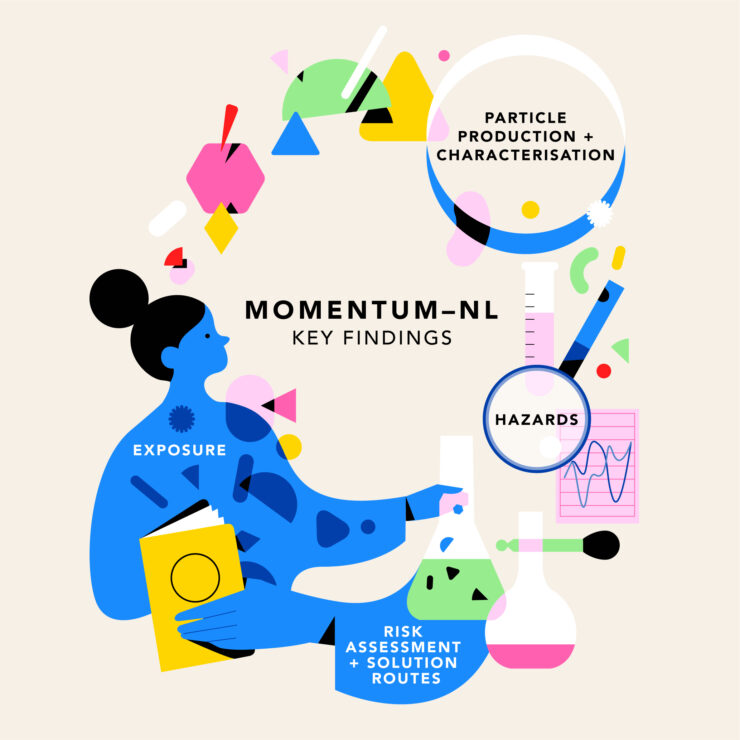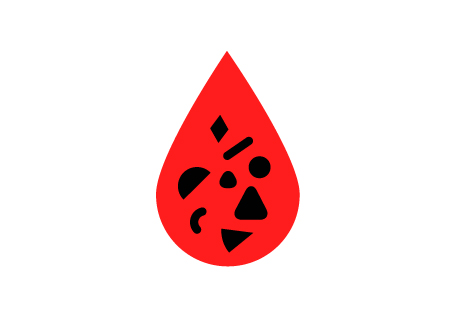Key findings

MOMENTUM-NL is a Dutch research network aimed at studying the human health effects of micro- and nanoplastics and developing solution routes to minimise their impact. Here, we present the key findings of our research to date, categorised into four research themes: micro- and nanoplastic production & characterisation, exposure, hazards, and risk assessment & solution routes.

Micro- and nanoplastic production & characterisation
- We produced reference micro- and nanoplastics (PA, PVC, PP, PET) to conduct research on microplastics in a standardised way.
- The particles were of different shapes, sizes, and plastic types and were weathered (exposed to heat and UV-light) to closely resemble the particles found in our environment.
- Their size, shape, and chemical properties were characterised and captured in a microplastics passport.

Exposure
- Computer modelling to identify the main sources of human exposure to micro- and nanoplastics is ongoing.
- Plants can take up polystyrene and PVC particles from the environment via their roots and transport these to their leaves: a previously unknown pathway for plastics into our diet.
- We optimised methods to measure micro- and nanoplastics in human blood, allowing more reliable detection and quantification.
- We developed methods to measure micro- and nanoplastics in other human tissues, including bronchial fluid, liver, spleen, and bile.
- Micro- and nanoplastics were present in 94% of tested human blood samples.
- We found micro- and nanoplastics in the tissues of animals that were exposed to polyamide (nylon) through inhalation and to polystyrene and PVC through intravenous injection.
- We have developed computer models to estimate absorption, distribution, and excretion of micro- and nanoplastics in the human body.
- Polystyrene MNPs can pass cellular barriers in the lungs, intestines, brains, and placenta in lab models. Studies with PVC particles are ongoing.
- Human microdosing studies to measure absorption, distribution, and excretion of micro- and nanoplastics are under development. Polystyrene particles have been radioactively labelled to enable detection in human blood, urine, and faeces.

Hazards
- There are indications of possible health effects of micro- and nanoplastics in lab models. They show toxicity to human cells depending on cell type, plastic type, and particle size.
- Cells from the lungs are the most sensitive to micro- and nanoplastics in lab models.
- Polyamide (nylon) particles are the most toxic, probably due to chemical additives. PVC particles also seem to cause toxic effects.
- We have made preliminary efforts to understand how effects measured in lab models translate to effects in humans by developing adverse outcome pathways.
- The presence of micro- and nanoplastics in blood may be associated with immune responses in young adults in an epidemiological study. Studies into the correlation of micro- and nanoplastics with immune responses in babies are ongoing.
- Pathogens can attach to plastic particles and persist in the environment for a long time. Further studies into the effects of these pathogens are ongoing.
- Studies are ongoing to determine if micro- and nanoplastics have more severe effects in unhealthy cells, such as inflamed cells or cells from patients suffering from inflammatory bowel disease.
- Our research extends to environmental species: Escargot, a common food item in southern Europe and a potential protein alternative for meat, excrete micro- and nanoplastics after exposure, but their growth is affected.

Risk assessment & solution routes
- Over 30 partners worked together in the MOMENTUM-NL cluster to better understand the risks of micro- and nanoplastics to human health and to translate scientific results into real-world applications and policy. This unique infrastructure will be continued with the MOMENTUM-NL collaborative network.
- A roadmap for risk assessment identified key goals and remaining knowledge gaps. Main knowledge gaps in external exposure are being filled through literature studies.
- We have developed tools for risk assessment, including methods to evaluate the quality of published data and approaches for probabilistic risk assessment.
- A case study on the risks of nylon inhalation to lung function is ongoing.
- A roadmap for solutions outlined various solution routes towards minimising the impact of micro- and nanoplastics on our health.
- We investigated microplastics awareness among the Dutch population. Only 33% of people knew that microplastics can be as small as a virus (100 nm). Eating and drinking were the most believed exposure routes while breathing and dermal contact were the least believed.
- We created a board game to raise awareness about microplastics among young people, with a focus on synthetic clothing.




